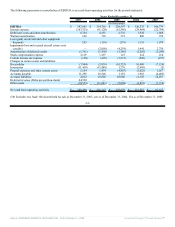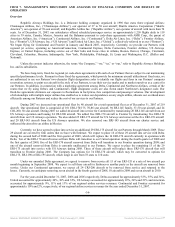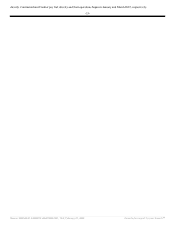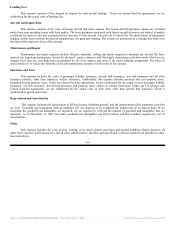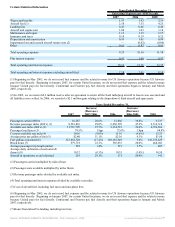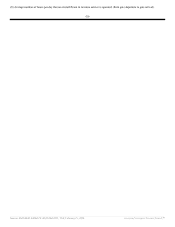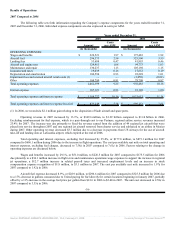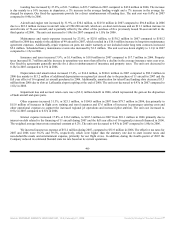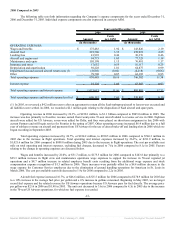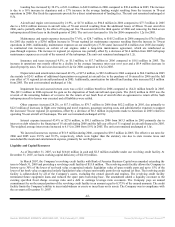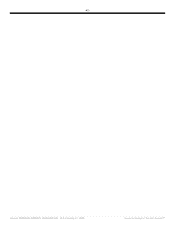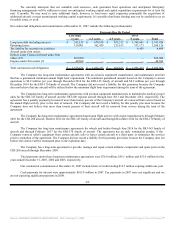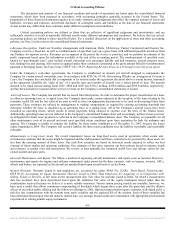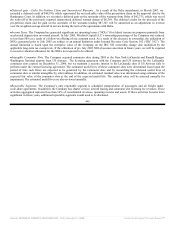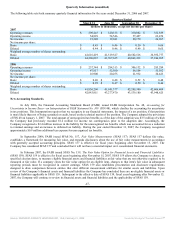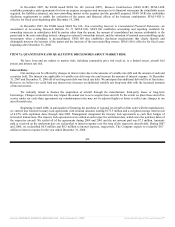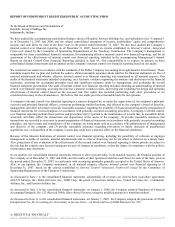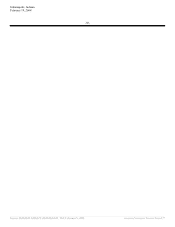Frontier Airlines 2007 Annual Report Download - page 52
Download and view the complete annual report
Please find page 52 of the 2007 Frontier Airlines annual report below. You can navigate through the pages in the report by either clicking on the pages listed below, or by using the keyword search tool below to find specific information within the annual report.
Landing fees increased by 38.2%, or $11.6 million, to $42.0 million in 2006 compared to $30.4 million in 2005. The increase
is due to a 16% increase in departures and a 17% increase in the average landing weight resulting from the increase in 70-seat
operations in 2006. Our fixed-fee agreements provide for a direct reimbursement of landing fees. The unit cost remained unchanged at
0.5¢.
Aircraft and engine rent increased by 21.9%, or $17.0 million, to $94.8 million in 2006 compared to $77.7 million in 2005
due to a $22.4 million increase in aircraft rents of 70-seat aircraft resulting from the additional leases of fifteen 70-seat aircraft in
2006, and is partially offset by the effect of buying out five 50-seat aircraft in the third quarter of 2006 and removing the final seven
turboprop aircraft from lease in the fourth quarter of 2005. The unit cost decreased to 1.0¢ for 2006 compared to 1.2¢ for 2005.
Maintenance and repair expenses increased by 37.6%, or $28.7 million, to $105.2 million in 2006 compared to $76.5 million
for 2005 due mainly to a $29.6 million increase in 70-seat regional jet maintenance expenses resulting from the increase in 70-seat
operations in 2006. Additionally, maintenance expenses on our smaller jets (37-50 seats) increased $5.4 million over 2005 due mainly
to contractual rate increases on certain of our engines under a long-term maintenance agreement, which are reimbursed as
pass-through expenses. The increase in regional jet expenses was partially offset by a decrease of $6.4 million from 2005 turboprop
maintenance expenses as a result of the removal of the turboprops. The unit cost remained unchanged at 1.2¢.
Insurance and taxes increased 9.5%, or $1.5 million, to $17.7 million in 2006 compared to $16.1 million in 2005. The
increase in operations was mostly offset by a decline in the average insurance rates year over year and a $0.4 million decrease in
aircraft property taxes. The unit cost decreased to 0.2¢ for 2006 compared to 0.3¢ in 2005.
Depreciation and amortization increased 42.2%, or $27.4 million, to $92.2 million in 2006 compared to $64.9 million in 2005
due mainly to $24.1 million of additional depreciation on regional jet aircraft due to the purchase of 16 aircraft in 2006 and the full
year effect of 31 regional jet aircraft purchased in 2005. Additionally, amortization for takeoff and landing slots increased $2.8 million
from 2005. The unit cost remained unchanged at 1.0¢.
Impairment loss and accrued return costs was a ($2.1) million benefit in 2006 compared to ($4.2) million benefit in 2005.
The ($2.1) million in 2006 represent the gain on the disposition of Saab aircraft and spare parts. The ($4.2) million in 2005 was the
reversal of the remaining balance of a reserve for the return of our Saab fleet of aircraft after an agreement to return all the Saab
turboprop aircraft to lessors was executed and all liabilities were settled.
Other expenses increased 28.2%, or $17.5 million, to $79.7 million in 2006 from $62.2 million in 2005, due primarily to
$22.5 million of increases in flight crew training and travel expenses, passenger catering costs, and administrative expenses to support
the increased 70-seat regional jet operations, offset by a decrease of $6.3 million in payments made to American in 2005 related to
operating 70-seat aircraft at Chautauqua. The unit cost remained unchanged at 0.9¢.
Interest expense increased 43.4% or $27.6 million, to $91.1 million in 2006 from $63.5 million in 2005 primarily due to
interest on debt related to the financing of 16 aircraft during 2006 and the full year effect of 31 regional jet aircraft financed in 2005.
The weighted average interest rate increased to 6.1% in 2006 from 5.6% in 2005. The unit cost remained unchanged at 1.0¢.
We incurred income tax expense of $51.9 million during 2006, compared to $39.5 million in 2005. The effective tax rates for
2006 and 2005 were 39.5% and 39.5%, respectively, which were higher than the statutory rate due to state income taxes and
non-deductible meals and entertainment expense, primarily for our flight crews.
Liquidity and Capital Resources
As of December 31, 2007, we had $164.0 million in cash and $2.5 million available under our revolving credit facility. At
December 31, 2007, we had a working capital deficiency of $(23.0) million.
In March 2007, the Company’s revolving credit facility with Bank of America Business Capital was amended extending the
term to March 31, 2009 and providing a revolving credit facility of $15.0 million. The revolving credit facility allows the Company to
borrow up to 30% of the lower of net book value or appraised orderly liquidation value of spare rotable parts and up to 15% of the
lower of net book value or appraised orderly liquidation value of spare non-rotable parts for our regional jet fleet. The revolving credit
facility is collateralized by all of the Company’s assets, excluding the owned aircraft and engines. The revolving credit facility
terminated future equipment loans and reduced the spare parts borrowing base. The amendment added a liquidity covenant to the
existing specified fixed charge coverage ratio and a debt to earnings leverage ratio covenants. The Company pays an annual
commitment fee on the unused portion of the revolving credit facility in an amount equal to 0.375% of the unused amounts. The credit
facility limits the Company’s ability to incur indebtedness or create or incur liens on its assets. The Company was in compliance with
the covenant at December 31, 2007.
-42-
Source: REPUBLIC AIRWAYS HOLDINGS INC, 10-K, February 21, 2008 Powered by Morningstar® Document Research℠


